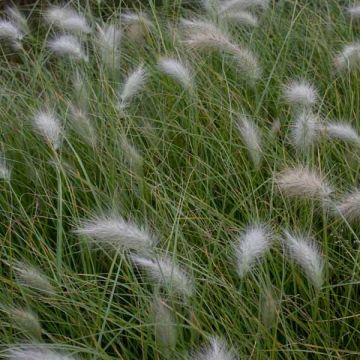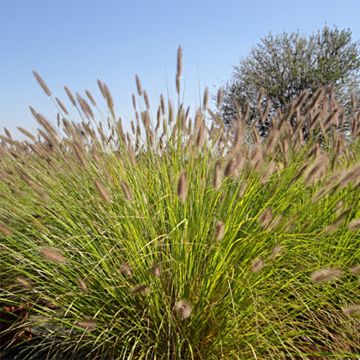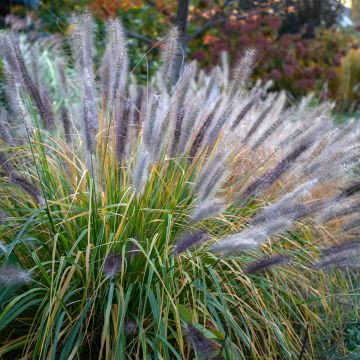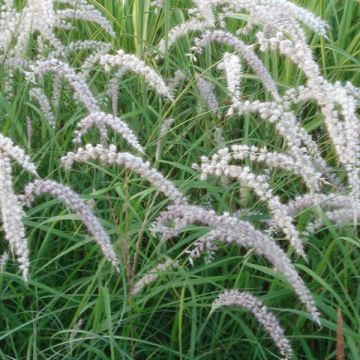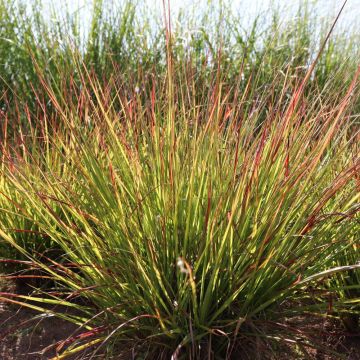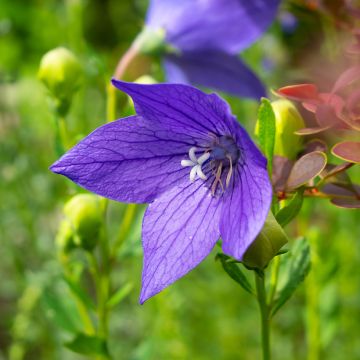

Pennisetum alopecuroides Goldstrich - Chinese Fountain Grass
Pennisetum alopecuroides Goldstrich - Chinese Fountain Grass
Pennisetum alopecuroides Goldstrich
Fountain Grass, Chinese Fountain Grass, Foxtail Fountain Grass, Swamp Foxtail Grass
This item cannot be shipped to the selected country
Delivery charge from €5.90
More information
Schedule delivery date,
and select date in basket
This plant carries a 12 months recovery warranty
More information
We guarantee the quality of our plants for a full growing cycle, and will replace at our expense any plant that fails to recover under normal climatic and planting conditions.
From €5.90 for pickup delivery and €6.90 for home delivery
Express home delivery from €8.90.
Does this plant fit my garden?
Set up your Plantfit profile →
Description
The Pennisetum alopecuroides 'Goldstrich' resembles the variety 'Hameln', but the golden-yellow flower stems bear its white flower heads with brown highlights at the end of the season. They inevitably evoke large, silky, plump and gracefully arched caterpillars, which have earned it the name of feather grass. Attractive from spring to autumn, this undemanding little grass forms a beautiful fountain of fabulous foliage adorned with beautiful autumn colours. It can be placed anywhere in annual and perennial beds, rockeries, or a large container on a patio.
Pennisetum alopecuroides is a grass native to Northeast Asia and Australia and belongs to the Poaceae family. The 'Goldstrich' feather grass evokes a cascade of leaves and spikes, 60 cm (24in) tall and wide. The basal tuft comprises wonderful, trailing leaves with a peculiar glaucous colour. The flowering culms emerge from the vegetation in summer, bearing characteristic inflorescences from July to September. They are composed of very silky spikelets gathered in particularly thick panicles, 10 to 15 cm (4 to 6in) long. Their colour changes from spring green-white to brown-beige-white in September-October, while the yellow hue of the stems intensifies. The foliage also celebrates the arrival of autumn with a flourish, turning bright red and orange under the sun. During the winter, the plant looks attractive when covered in frost.
This plant variety is small yet delicate and can add a touch of flexibility to any landscape by fitting in between more rigid perennials like dahlias or perovskias. It can also be paired with lighter plants such as yarrows, Verbena bonariensis, Californian poppies or eupatoriums. By combining these plants, you can create a beautiful, attractive, and visually appealing garden. The Pennisetum alopecuroides are very hardy grasses and resistant to summer drought that bring movement to flower beds strategically placed between rocks in a rockery or on a wall. These grasses take on an incomparable brilliance in low light and transparently emphasise all perspectives, even in the smallest of gardens. The Pennisetum also has the advantage of limiting erosion through its dense root system.
Report an error about the product description
Pennisetum alopecuroides Goldstrich - Chinese Fountain Grass in pictures




Flowering
Foliage
Plant habit
Botanical data
Pennisetum
alopecuroides
Goldstrich
Poaceae
Fountain Grass, Chinese Fountain Grass, Foxtail Fountain Grass, Swamp Foxtail Grass
Cultivar or hybrid
Other Pennisetum
Planting and care
To plant Pennisetum alopecuroides 'Goldstritch', follow these steps:
1. Dig a hole 20 cm (8in) deep and wide in a spot with full sun.
2. Choose light and well-drained soil that is moist to moderately dry, slightly acidic, neutral or limestone to suit this plant's preference.
3. If the soil is heavy, mix some coarse sand, gravel and compost to improve its texture.
4. Partially fill the hole, then remove the plant from its pot and place it so that the top of the root ball is covered with 3 cm (1in) of soil.
5. Firm the soil around the plant and water generously to eliminate air pockets.
6. If the weather is dry, water regularly for a few weeks to help the plant establish properly.
Planting period
Intended location
Care
-
, onOrder confirmed
Reply from on Promesse de fleurs
Summer flowering perennials
Haven't found what you were looking for?
Hardiness is the lowest winter temperature a plant can endure without suffering serious damage or even dying. However, hardiness is affected by location (a sheltered area, such as a patio), protection (winter cover) and soil type (hardiness is improved by well-drained soil).

Photo Sharing Terms & Conditions
In order to encourage gardeners to interact and share their experiences, Promesse de fleurs offers various media enabling content to be uploaded onto its Site - in particular via the ‘Photo sharing’ module.
The User agrees to refrain from:
- Posting any content that is illegal, prejudicial, insulting, racist, inciteful to hatred, revisionist, contrary to public decency, that infringes on privacy or on the privacy rights of third parties, in particular the publicity rights of persons and goods, intellectual property rights, or the right to privacy.
- Submitting content on behalf of a third party;
- Impersonate the identity of a third party and/or publish any personal information about a third party;
In general, the User undertakes to refrain from any unethical behaviour.
All Content (in particular text, comments, files, images, photos, videos, creative works, etc.), which may be subject to property or intellectual property rights, image or other private rights, shall remain the property of the User, subject to the limited rights granted by the terms of the licence granted by Promesse de fleurs as stated below. Users are at liberty to publish or not to publish such Content on the Site, notably via the ‘Photo Sharing’ facility, and accept that this Content shall be made public and freely accessible, notably on the Internet.
Users further acknowledge, undertake to have ,and guarantee that they hold all necessary rights and permissions to publish such material on the Site, in particular with regard to the legislation in force pertaining to any privacy, property, intellectual property, image, or contractual rights, or rights of any other nature. By publishing such Content on the Site, Users acknowledge accepting full liability as publishers of the Content within the meaning of the law, and grant Promesse de fleurs, free of charge, an inclusive, worldwide licence for the said Content for the entire duration of its publication, including all reproduction, representation, up/downloading, displaying, performing, transmission, and storage rights.
Users also grant permission for their name to be linked to the Content and accept that this link may not always be made available.
By engaging in posting material, Users consent to their Content becoming automatically accessible on the Internet, in particular on other sites and/or blogs and/or web pages of the Promesse de fleurs site, including in particular social pages and the Promesse de fleurs catalogue.
Users may secure the removal of entrusted content free of charge by issuing a simple request via our contact form.
The flowering period indicated on our website applies to countries and regions located in USDA zone 8 (France, the United Kingdom, Ireland, the Netherlands, etc.)
It will vary according to where you live:
- In zones 9 to 10 (Italy, Spain, Greece, etc.), flowering will occur about 2 to 4 weeks earlier.
- In zones 6 to 7 (Germany, Poland, Slovenia, and lower mountainous regions), flowering will be delayed by 2 to 3 weeks.
- In zone 5 (Central Europe, Scandinavia), blooming will be delayed by 3 to 5 weeks.
In temperate climates, pruning of spring-flowering shrubs (forsythia, spireas, etc.) should be done just after flowering.
Pruning of summer-flowering shrubs (Indian Lilac, Perovskia, etc.) can be done in winter or spring.
In cold regions as well as with frost-sensitive plants, avoid pruning too early when severe frosts may still occur.
The planting period indicated on our website applies to countries and regions located in USDA zone 8 (France, United Kingdom, Ireland, Netherlands).
It will vary according to where you live:
- In Mediterranean zones (Marseille, Madrid, Milan, etc.), autumn and winter are the best planting periods.
- In continental zones (Strasbourg, Munich, Vienna, etc.), delay planting by 2 to 3 weeks in spring and bring it forward by 2 to 4 weeks in autumn.
- In mountainous regions (the Alps, Pyrenees, Carpathians, etc.), it is best to plant in late spring (May-June) or late summer (August-September).
The harvesting period indicated on our website applies to countries and regions in USDA zone 8 (France, England, Ireland, the Netherlands).
In colder areas (Scandinavia, Poland, Austria...) fruit and vegetable harvests are likely to be delayed by 3-4 weeks.
In warmer areas (Italy, Spain, Greece, etc.), harvesting will probably take place earlier, depending on weather conditions.
The sowing periods indicated on our website apply to countries and regions within USDA Zone 8 (France, UK, Ireland, Netherlands).
In colder areas (Scandinavia, Poland, Austria...), delay any outdoor sowing by 3-4 weeks, or sow under glass.
In warmer climes (Italy, Spain, Greece, etc.), bring outdoor sowing forward by a few weeks.

































